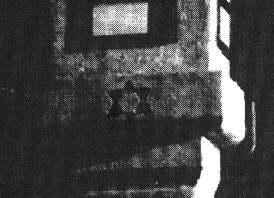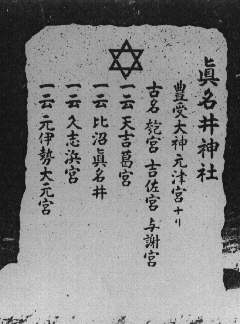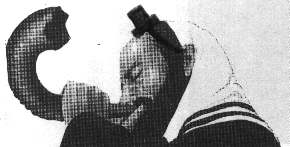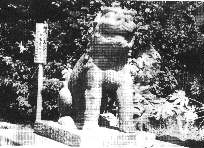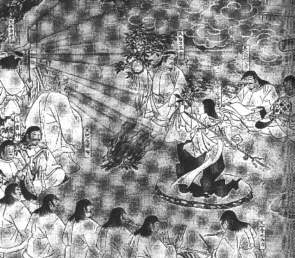JAPANESE SHINTO : LOST TRIBE OF YAHWEH (LAND OF THE RISING SUN GOD)
Posted by HATTER on August 6, 2014
Posted in: JAPAN. Tagged: JAPAN. Leave a comment
.

.
JAPAN : LAND OF THE RISING SUN
.
ISRAELITES CAME TO JAPAN Many of the traditional ceremonies in Japan seem to be the traces that the Ten Lost Tribes of Israel came to ancient Japan.
Arimasa Kubo A Japanese Festival Illustrates the Story of Isaac. In Nagano prefecture, Japan, there is a large Shinto shrine named “Suwa-Taisha” (Shinto is the traditional religion peculiar to Japan.) At Suwa-Taisha, the traditional festival called “Ontohsai” is held on April 15 every year. This festival illustrates the story of Isaac in chapter 22 of Genesis in the Bible, that is, the story that Abraham was about to sacrifice his own son Isaac. The festival “Ontohsai” has been held since ancient days and has been thought of as the most important festival of “Suwa-Taisha.”

Next to the shrine “Suwa-Taisha,” there is a mountain called Mt. Moriya (“Moriya-san” in Japanese). And the people from the Suwa area call the god of Mt. Moriya “Moriya no kami” which means “the god of Moriya.” At the festival, a boy is tied up by a rope to a wooden pillar, and placed on a bamboo carpet. A Shinto priest comes to him preparing a knife, but then a messenger (another priest) comes there, and the boy is released. It reminds us of the story that Isaac was released after an angel comes to Abraham.
At this festival, animal sacrifices are also offered. 75 deer are sacrificed, but among them it is believed that there is a deer with its ears split. The deer is believed to be the one God prepared. It may have some connection with the ram that God prepared and was sacrificed after Isaac was released. Even in historic times, people thought that this custom of deer sacrifice was strange, because animal sacrifice is not a Shinto tradition.
People call this festival “the festival for Misakuchi-god”. “Misakuchi” might be “mi-isaku-chi.” “Mi” means “great,” “isaku” is probably Isaac (the Hebrew word “Yitzhak”), and “chi” is something for the end of the word. It seems that the people of Suwa made Isaac a god, probably by the influence of idol worshipers.
Today, this custom of the boy about to be sacrificed and then released, is no longer practiced, but we can still see the custom of the wooden pillar called “oniye-basira” which means “sacrifice-pillar.”
Today, people use stuffed animals instead of performing a real animal sacrifice. Tying a boy along with animal sacrifice was regarded as savage by people of the Meiji-era (about 100 years ago), and those customs were discontinued. But the festival itself still remains today.
The custom of the boy had been maintained until the beginning of Meiji era. Masumi Sugae, who was a Japanese scholar and a travel writer in the Edo era (about 200 years ago), wrote a record of his travels and noted what he saw at Suwa. The record shows the details of “Ontohsai.” It tells that the custom of the boy about to be sacrificed and his ultimate release, as well as animal sacrifices, existed in those days. His records are kept at the museum near Suwa-Taisha.
The festival of “Ontohsai” has been maintained by the Moriya family ever since ancient times. The Moriya family think of “Moriya-no-kami” (god of Moriya) as their ancestor’s god. And they think of “Mt. Moriya” as their holy place. The name “Moriya” may have come from “Moriah” (the Hebrew word “Moriyyah”) of Genesis 22:2.
The Moriya family have been hosting the festival for 78 generations. The festival of Ontohsai must have existed since ancient times.
I am not aware of any country, other than Japan, which has a festival illustrating the story of Isaac. I believe that this tradition provides strong evidence that the Israelites came to ancient Japan.
The Crest of the Imperial House of Japan Is the Same As That Found On Gates of Jerusalem. The crest of the Imperial House of Japan is a round mark in the shape of a flower with 16 petals (photo right). Today’s shape looks like a chrysanthemum (mum), but scholars say that in ancient times, it rather looked like a sunflower. This is indeed the same shape as the mark at Herod’s gate in Jerusalem. The crest at Herod’s gate also has 16 petals (photo left).
.

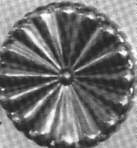
This crest of the Imperial House of Japan has existed since very ancient times, as well as Herod’s gate.
The Star of David Is A Symbol Also Used At Ise-jingu, the Shinto Shrine for the Imperial House of Japan. Ise-jingu in Mie-pref., Japan, is the Shinto shrine built for the Imperial House of Japan. On both sides of the approaches to the shrine, there are street lamps made of stone. You can see the Jewish Star of David carved on each of the lamps near the top.
The crest used on the inside of the shrine (Izawa-no-miya) at Ise-jingu is also the Star of David. This has existed since ancient times.
In Kyoto pref., there is a shrine called “Manai-jinja” which was the original Ise-jingu Shrine. The crest of “Manai-jinja” is also the Star of David. So, this has been used since ancient times.
I heard that the Star of David had been discovered at a Jewish synagogue of the third century in Europe, too.
Japanese Religious Priests “Yamabushi” Put A Black Box on their Foreheads Just As Jews Put A Phylactery on their Foreheads. “Yamabushi”s are religious men in training and are unique to Japan. Today, they are thought to belong to Japanese Buddhism. But the Buddhism in China, Korea, or India have no such custom. The custom of “yamabushi” has existed in Japan before Buddhism was imported into Japan in the seventh century.
The clothes worn by the “yamabushi” are basically white. On his forehead, he puts a black small box called a “tokin”, which is tied to his head with a black cord. He really resembles a Jew putting on a phylactery (black box) on his forehead with a black cord. The size of this black box “tokin” is almost the same as the Jewish phylactery. But the shape of the “tokin” is round and looks like a flower.
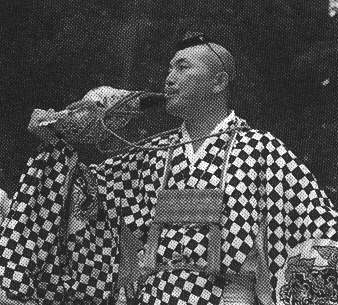
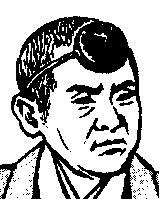
Originally the Jewish phylactery placed on the forehead seems to have come from the forehead “plate” put on the high priest Aaron with a cord (Exodus 28:36-38). It was about 4 centimeters (1.6 inches) in size according to the folklore, and some scholars say that this was in the shape of a flower. If so, it was very similar to the shape of the Japanese “tokin” worn by the “yamabushi”.
Israel and Japan are the only two countries that in the world I know of that use the forehead box.
Furthermore, the “Yamabushi” use a big seashell as a horn. This is very similar to a Jew blowing a shofar, or ram’s horn. The way it is blown, sounds of the yamabushi’s horn are very much like a shofar. And there are no sheep in Japan, the “Yamabushi” had to use seashell horns instead of rams’ horns.
“Yamabushi”s are people who regard mountains as their holy places for religious training. The people of Israel also regarded mountains as their holy places. The Ten Commandments of the Torah were given on Mt. Sinai. Jerusalem is a city on a mountain. Jesus (Yeshua) used to climb up the mountain to pray there. His transfiguration also occurred on a mountain.
In Japan, there is the legend of “tengu” who lives on a mountain and has the figure of a “yamabushi”. He has a pronounced nose and supernatural capabilities. A “Ninja”, who was an agent or spy in the old days while working for his lord, goes to “tengu” at the mountain to get from him supernatural abilities. “Tengu” gives him a “tora-no-maki” (a scroll of the “tora”) after giving him additional powers. This “scroll of the tora” is regarded as a very important book which is helpful for any crisis. The Japanese use this word sometimes in their daily life even today.
We do not have any knowledge that a real scroll of a Jewish Torah was ever found in a Japanese historical site. But I can’t help but think that this “scroll of the tora” is a usage of the holy book called “Torah”, used by Jews to this day.
Japanese “Omikoshi” Resembles the Ark of the Covenant. In the Bible, in First Chronicles chapter 15, it is written that David brought up the ark of the covenant of the Lord into Jerusalem.
“David and the elders of Israel and the commanders of units of a thousand went to bring up the ark of the covenant of the LORD from the house of Obed-Edom, with rejoicing. …Now David was clothed in a robe of fine linen, as were all the Levites who were carrying the ark, and as were the singers, and Kenaniah, who was in charge of the singing of the choirs. David also wore a linen ephod. So all Israel brought up the ark of the covenant of the LORD with shouts, with the sounding of rams’ horns and trumpets, and of cymbals, and the playing of lyres and harps.” (15:25-28)
When I read these passages, I think; “How well does this look like the scene of Japanese people carrying the ‘omikoshi’ during festivals? The shape of the Japanese ‘Omikoshi’ really looks like the ark of the covenant. Japanese people sing and dance in front of it with shouts, and with the sounding of musical instruments. These are very similar to the customs of ancient Israel.”
Japanese people carry the “omikoshi” on their shoulders with poles – usually two poles. So did the ancient Israelites:
“The Levites carried the ark of God with poles on their shoulders, as Moses had commanded in accordance with the word of the LORD.” (1 Chronicles 15:15)
The Israeli ark of the covenant had two poles (Exodus 25:10-15). Some restored models of the ark as it was imagined to be, have been using two poles on the upper parts of the ark. But the Bible says those poles were to be fastened to the ark by the four rings “on its four feet” (Exodus 25:12). So the poles must have been attached on the bottom of the ark. This is similar to the Japanese “omikoshi.”
The Israeli ark had two statues of gold cherubim on its top. Cherubim are a kind of angel, a mysterious heavenly being. They have wings like birds. Japanese “omikoshi” also have on its top the gold bird called “Ho-oh” which is an imaginary bird and a mysterious heavenly being. The entire Israeli ark was overlaid with gold. Japanese “omikoshi” are also overlaid mostly with gold. The size of “omikoshi” is almost the same as the Israeli ark. Japanese “omikoshi” may be a remnant of the ark of ancient Israel.
Many Things Concerning the Ark Resemble Japanese Customs. King David and people of Israel sang and danced with the sounding of musical instruments in front of the ark. The Japanese sing and dance with the sounding of musical instruments in front of “omikoshi,” as well.
Several years ago, an American-made movie titled “King David” which was a faithful story of the life of King David. In the movie, David was dancing in front of the ark when bringing up the ark into Jerusalem. I “If the scenery of Jerusalem were replaced by Japanese scenery, this scene would be just the same as what one sees here at festivals in Japan.”
The atmosphere of the music also resembled Japanese. David’s dancing really looked like Japanese traditional dancing.
At the Shinto shrine festival of “Gion-jinja” in Kyoto, men carry “omikoshi,” then go into the water, and cross a river. I can’t help but think this originates from the memory of the Ancient Israelites carried the ark as they crossed the Jordan river after their exodus from Egypt.
In an island of Inland Sea of Seto of Japan, the men who were selected as the carriers of the “omikoshi”, stay together at a house for one week before they would carry the “omikoshi.” This is to prevent profaning themselves. Furthermore, on the day before they carry “omikoshi,” they bathe in seawater to sanctify themselves. This is the same custom as the ancient Israelites':
“So the priests and the Levites sanctified themselves to bring up the ark of the Lord God of Israel.” (1 Chronicles 15:14)
The Bible says that after the ark entered Jerusalem and the march was finished; “David distributed to everyone of Israel, both man and woman, to everyone a loaf of bread, a piece of meat, and a cake of raisins” (1 Chronicles 16:3). This is the same custom as the Japanese. Sweets are distributed to everyone after a festival in Japan as well. It was a delight during my childhood.
The Robe of Japanese Priests Resembles the Robe of Israeli Priests. The Bible says that when David brought up the ark into Jerusalem; “David was clothed in a robe of fine linen” (1 Chronicles 15:27). So were priests and choirs. In the Japanese Bible, this verse is translated into “robe of white linen.”
In ancient Israel, although the high priest wore a colorful robe, other ordinary priests wore simple white linens. Priests wore white clothes at holy events. So do Japanese priests wear white robes at holy events. In Ise-jingu, one of the oldest shrines of Japan, all the priests wear white robes. And in many Shinto shrines of Japan, people wear white robes when they carry the “omikoshi” just like the Israelites did. Buddhist priests wear luxurious colorful robes. But in the Japanese Shinto religion, white is regarded as the most holy color.
The Emperor of Japan, just after he finished the ceremony of his accession to the throne, comes alone in front of the Shinto god. When he comes there, he wears pure white robe on his whole body. Furthermore, with his feet naked. This is the same as when Moses and Joshua removed their sandals in front of God in bare feet (Exodus 3:5, Joshua 5:15).
Marvin Tokayer, a rabbi who lived in Japan for 10 years, wrote in his book:
“The linen robes which Japanese Shinto priests wear have the same figure as the white linen robes of the ancient priests of Israel. ”
The robe of the Japanese Shinto priest has cords of 20-30 centimeters long (about 10 inches) hung from the corners of the robe. These fringes are the custom of the Israelites. Deuteronomy 22:12 says:
“make them fringes in the corners of their garments throughout their generations.” Fringes (tassels) were a token that he was an Israelite. In the gospels of the New Testament, it is also written that the Pharisees “make their tassels on their garments long” (Matthew 23:5). A woman who had been suffering from a hemorrhage came to Jesus (Yeshua) and touched the “tassel on His coat” (Matthew 9:20, The New Testament: A Translation in the Language of the People, translated by Charles B. Williams). Imagined pictures of ancient Israeli clothing sometimes do not have fringes. But their robes actually had fringes. The Jewish Tallit (prayer shawl), which the Jews put on when they pray, has fringes in the corners according to tradition.
Japanese Shinto priests wear on their robe a rectangle of cloth from their shoulders to thighs. This is the same as the ephod worn by David:
“David also wore a linen ephod.” (1 Chronicles 15:27) Although the ephod of the high priest was colorful with jewels, the ordinary priests under him wore the ephods of simple white linen cloth (1 Samuel 22:18). Rabbi Tokayer says that the rectangle of cloth on the robe of Japanese Shinto priest looks very similar to the ephod of the Kohen, the Jewish priest.
The Japanese Shinto priest puts a cap on his head just like Israeli priest did (Exodus 29:40). The Japanese priest also puts a sash on his waist. So did the Israeli priest. The clothing of Japanese Shinto priests must be that used by ancient Israelites.
Waving the Sheaf of Harvest Is Also the Custom of Japan. The Jews wave a sheaf of their harvest stacks of grain seven weeks before Shavuot (Pentecost, Leviticus 23:10-11), They do this also at the Feast of Booths (Sukkot, Leviticus 23:40). This has been a tradition since the time of Moses. Ancient Israeli priests also waved a plant branch when he sanctifies someone. David said, “Purge me with hyssop, and I shall be clean” [Psalm 51:7(9)]. This is also a traditional Japanese custom.
When a Japanese priest sanctifies someone or something, he waves a plant branch. Or, he waves a “harainusa” which is like a plant branch. Today’s “harainusa” is simplified and made of white paper that is folded in a zig-zag pattern like small lightning bolts, but in old days it was a plant branch or cereals.
A Japanese Christian woman I know used to think of this “harainusa” as just a pagan custom. But she later went to the USA, and had an opportunity to attend a Sukkot meeting. When she saw the Jewish waving of the sheaf of the harvest, she shouted in her heart, “Oh, this is the same as a Japanese priest does! Here lies the home for the Japanese.”
The Structure of the Japanese Shinto Shrine is the Same As God’s Tabernacle of Ancient Israel. The inside of God’s tabernacle in ancient Israel was divided into two parts. One is the Holy Place, and another the Holy of Holies. So is the Japanese Shinto shrine. It is divided into two parts.
The functions prepared in the Japanese shrine are similar to the ones of the Israeli tabernacle. Japanese people pray in front of its Holy Place. They cannot enter inside. Only Shinto priests can enter. Shinto priest enters the Holy of Holies only at special times. This is the same as the Israeli tabernacle.
The Holy of Holies of Japanese Shinto shrine is located in far west as in the Israeli tabernacle. Shinto’s Holy of Holies is also located on a higher level than the Holy Place, and between them there are steps. Scholars say that, in the Israeli temple built by Solomon, the Holy of Holies was on an elevated level as well, and between them there were steps of about 2.7 meters (9 feet) wide.
In front of a Japanese shrine, there are two statues of lions called “komainu” that sit on both sides of the approach. They are not idols, but guards for the shrine. This is also a custom of ancient Israel. In God’s temple in Israel and in the palace of Solomon, there were statues or relieves of lions (1 Kings 7:36, 10:19).
In the early history of Japan, there were absolutely no lions. But the statues of lions have been placed in Japanese shrines since ancient times. It has been proven by scholars that statues of lions located in front of Japanese shrines originated from the Middle East.
Located near the entrance of a Japanese shrine, there is “temizuya” which is a place for worshipers to wash their hands and mouth. This is the same custom as found in Jewish synagogues. The ancient tabernacle and temple of Israel also had a laver for washing and sanctification near the entrances well.
In front of a Japanese shrine, there is a gate called the “torii.” The gate of this style does not exist in China or in Korea, it is peculiar to Japan. The “torii” gate consists of two vertical pillars and a bar connecting the upper parts. But the oldest form consists of only two vertical pillars and a rope connecting the upper parts. When a Shinto priest bows to the gate, he bows to the two pillars separately. It is assumed that the “torii” gate was originally constructed of only two pillars.
In the Israeli temple, there were two pillars used as a gate (1 Kings 7:21). And in Aramaic language which ancient Israelites used, the word for gate was “taraa.” This word might have changed slightly and become the Japanese “torii”. Some “torii”s, especially of old shrines, are painted red. I can’t help but think this is a picture of the two door posts and the lintel on which the blood of the lamb was put the night before the exodus from Egypt.
In the Japanese Shinto religion, there is a custom to surround a holy place with a rope called the “shimenawa” which has slips of white papers inserted along the bottom edge of the rope. The “simenawa” rope is set as the boundary. The Bible says that when Moses was given God’s Ten Commandments on Mt. Sinai, he “set bounds” (Exodus 19:12) around it for the Israelites not to approach. Although I don’t know what kind of things these “bounds” were, ropes or something else must have been set as the boundary. The Japanese “shimenawa” rope might then be a custom that originates from the time of Moses.
The only big difference between a Japanese shrine and the ancient Israeli temple is that a Shinto shrine does not have the burning altar for animal sacrifices. I used to wonder why Shinto religion does not have the custom of animal sacrifices if Shinto originates from the religion of ancient Israel. But then I found the answer in Deuteronomy chapter 12. Moses commanded people not to offer any animal sacrifices at any other locations except at specific places in Canaan (12:10-14). So, if the Israelites came to ancient Japan, they would not be permitted to offer animal sacrifices.
Many Japanese Customs Resemble the Customs of Ancient Israel. When Japanese people pray in front of the Holy Place of a Shinto shrine, they firstly ring the golden bell which is hung at the center of the entrance. This is the custom of the ancient Israel. The high priest Aaron put “bells of gold” on the hem of his robe. This was so that its sound might be heard and he might not die when he ministered there (Exodus 28:33-35).
Japanese people clap their hands two times when they pray there. This was, in ancient Israel, the custom to mean “I keep promises.” In the Scriptures, you can find the word which is translated as “pledge.” The original meaning of this word in Hebrew is “clap his hand” (Ezekiel 17:18, Proverbs 6:1). It seems that ancient people of Israel clapped their hands when they pledge or when they do an important thing.
Japanese people bow in front of the shrine before and after clapping their hands and praying. They also perform a bow as a polite greeting when they meet each other. To bow was also the custom of the ancient Israel. Jacob bowed when he was approaching Esau (Genesis 33:3). I have noticed that modern Jews do not bow. However, they bow when reciting prayers. Modern Ethiopian people have the custom of bowing, probably because of the ancient Jews who emigrated to Ethiopia in ancient days. The Ethiopian bow is similar to the Japanese.
The Japanese have the custom to use salt for sanctification. People sometimes sow salt after an offensive person left them. In a TV drama from the times of the Samurai, a woman threw salt on the place where a man she hated left. This custom is the same as that of the ancient Israelites. After Abimelech captured an enemy city, “he sowed it with salt” (Judges 9:45). We Japanese quickly understand this to mean to cleanse and sanctify the city.
When Jews move to a new house they sow it with salt to sanctify and cleanse it. Again this is the same in Japan. In Japanese-style restaurants, they usually put salt near the entrance. Jews also use salt for Kosher meat. All Kosher meat is purified with salt and all meals start with bread and salt.
Japanese people place salt at the entrance of a funeral home. After coming back from a funeral, one has to sprinkle salt on oneself before entering his own house, for it is thought in Shinto that anyone who went to a funeral or touched a dead body has become unclean. Again the same concept as the Israelites.
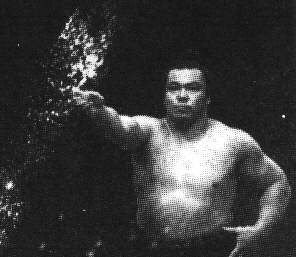
Japanese “sumo” wrestlers sow the sumo ring with salt before they fight. European or American people wonder why they sow salt. But Rabbi Tokayer wrote that Jews quickly understand its meaning. Japanese people offer salt every time they perform a religious offering, This is the same custom used by the Israelites, for the Bible says: “With all your offerings you shall offer salt.” (Leviticus 2:13) Japanese people in ancient times had the custom to put some salt into baby’s first bath. The ancient people of Israel washed a new born baby with water after rubbing the baby softly with salt (Ezekiel 16:4). Sanctification and cleansing with salt and/or water is a common custom among both the Japanese and Israelites.
In the Hebrew Scriptures, the words “clean” or “unclean” often appears. Europeans and Americans are not familiar with this concept. But the Japanese people easily understand it, for it is Shinto’s central concept to value cleanness and to avoid uncleanness. This concept again probably from ancient Israel.
In Japanese Shinto Religion, There Are No Idols Likewise Israeli Religion. Buddhist temples have idols which are carved in the shape of Buddha and other gods. But in Japanese Shinto shrines, there are no idols. In the center of the Holy of Holies of a Shinto shrine, there is a mirror, sword, or pendant. But Shinto believers do not regard these items as their gods. In Shinto, gods are thought to be invisible. The mirror, sword, and pendant are not idols, but merely objects to show that it is the holy place where invisible gods come down.
In the ark of the covenant of ancient Israel, there were the tablets of stone of God’s Ten Commandments, a jar of manna, and the rod of Aaron. These were not idols, but objects to show that it was the holy place where the invisible God comes down. We can say the same thing concerning these objects in Japanese shrines.
Ancient Japanese People Had the Belief in Yahweh!? There is a difference that Shinto religion believes in many gods, while the Israeli (Jewish) religion believes in only one God.
However, different from the modern Judaism, ancient religion of Israel, especially of the Ten Lost Tribes of Israel, inclined to idol worship and polytheistic belief (belief in many gods). They believed in not only a God Yahweh, but also Baal, Asytaroth, Molech, and other pagan gods. Practically the religion of ancient Israel was not monotheistic. Shinto’s polytheistic belief seems to have come from the polytheistic inclination of ancient Israel. Shinto scholars say that a Shinto god “Susanoh” resembles Baal in several aspects, and a female Shinto god “Amaterasu” resembles Asytaroth.
Until 40 decades ago, at Mt. Inomure in Ooita pref., Japan, people had held a ceremony to beg rainfall. They put woods together in the shape of the Star of David for making the foundation, on it constructed a tower made of tree branches, and on its top put a bamboo pole tangled with a slough of snake. They burned the tower and prayed for rainfall. It reminds us of the story that ancient Israelites had burned incense to the bronze serpent (made by Moses) on the pole until the reign of the King Hezekiah (2 Kings 18:4).
Although Shinto is a polytheistic religion, I think there is a possibility that ancient Shinto had once believed in Yahweh also.
The first born among the Shinto gods is called “Amenominakanushi-no-kami.” This god is said to have appeared first, live in the midst of the universe, have no shape, no dying, be the invisible master of the universe, and be the absolute god, who resembles the Biblical God as the Master of the universe.
Archaeologists say that the religions of Babylon and of Egypt had originally believed in one god called “the god of sky,” which seemed to have a connection to the Biblical “God of heaven.” Later, their religions degraded to the polytheism. I think that we can safely say the same thing happened to the Shinto religion. I suppose that the ancient Shinto religion had the belief in God Yahweh, but later degenerated into polytheism.
Mr. Tsujii, once told a story. One day, Mr. Tsujii’s friend who is a passionate Shinto believer came to him. The Shinto believer brought the Bible and said excitingly to Mr. Tsujii:
“I read the Torah. I was very surprised to know the religious ceremonies of ancient Israel. The ways of them are the same as Shinto’s! The way of their festivals, the way of the Temple, the way to value cleanness, all of them are the same as Shinto’s!” Then, Mr. Tsujii said to him:
“Yes, that is what I have also noticed. If you have noticed it, why don’t you believe in God whom the Bible teaches? I believe that is the way to establish and recover the true Shinto religion in which you believe.” Hearing it, the Shinto believer was too surprised to say any more words for a while.
Festivals of Japan Resemble the Festivals of Ancient Israel. Today the Japanese celebrate the new year on January 1st, but historically they used the lunar calendar, when January 15th was the official date for the new year celebration. It is a Japanese custom during the celebration to eat “mochi” (rice cakes) throughout the seven days. This is similar custom to the Jewish, for the Bible states:
“And on the fifteenth day of the same month (first month) is the Feast of Unleavened Bread to the Lord; seven days you must eat unleavened bread.” (Leviticus 23:6)
The recipe for “unleavened bread” is the same for Japanese “mochi,” because if you use rice as the ingredient instead of wheat flour, it would become Japanese “mochi.” The Hebrew word for unleavened bread” is “matsah.” I can’t believe that it is an accident that these two words sound alike.
Furthermore, the Japanese people eat porridge with seven kinds of bitter herbs during celebration. In historical times people ate the herbs on January 15. The ancient Israelites also ate “with bitter herbs” on the 15th of the first month (Exodus 12:8).
In Japan, they have the “Gion” festivals at many locations during summer. The most important is the one held at the “Yasaka-jinja” Shinto shrine in Kyoto. The festival in Kyoto continues throughout July each year. But, the most important part of the festival is held from the 17th to the 25th of July (We Japanese call it “the seventh month”). The 1st and 10th of July are also important. This has been a tradition since ancient times. But the 17th of the seventh month is the day that Noah’s ark drifted to Ararat:
“Then the ark rested in the seventh month, the seventeenth day of the month, on the mountains of Ararat.” (Genesis 8:4)
We can imagine that the ancient Israelites had a thanksgiving feast on this day. But after Moses, it was replaced by the Feast of Booths (harvest festival) which is held on the 1st, 10th day of the seventh month, and during 8 days from the 15th of the seventh month (Numbers 29:1, 7, 12, 35).
The “Gion” festival in Kyoto started with the wish that no pestilence would occur among people. This is similar to what King Solomon started, in the wish that no pestilence would occur in the country, the feast which continued for 8 days (including the last meeting day) from the 15th of the seventh month (2 Chronicles 7:8-10). Over 120 years ago, a business man from Scotland, N. Mcleod, came to Japan and investigated the customs of Japan. He wrote a book titled “Epitome of Japanese Ancient History.” In the book, he wrote that the “Gion” festival in Kyoto resembled Jewish festivals very much. Rabbi Tokayer made a similar comment. He said that the name “Gion” reminds him of “Zion” which is another name used for Jerusalem. In fact, Kyoto used to be called “Heian-kyo” which means “peace”. Jerusalem in Hebrew also means “peace”. “Heian-kyo” might be Japanese for “Jerusalem.”
At the “Gion” festival in Kyoto, people start the festival with a shout of “en-yara-yah.” The Japanese do not understand the meaning of this Japanese word. But, Eiji Kawamorita, a Japanese scholar and a Christian pastor who mastered Hebrew, wrote in his book that this word came from the Hebrew expression “eni ahalel yah” which means “I praise Yahweh (the Lord).”
Old Japanese Words Have Hebrew Origin. Joseph Eidelberg, a Jew who once came to Japan and stayed for years at a Japanese Shinto shrine, wrote a book titled “The Japanese and the Ten Lost Tribes of Israel.” He wrote that many Japanese words originated from ancient Hebrew.
For instance, the Japanese say “hazukashime” to mean disgrace or humiliation. In Hebrew, it is “hadak hashem” (tread down the name. See Job 40:12). The pronunciation and the meaning of them are both almost the same.
They say “anta” to mean “you,” which is the same in Hebrew. Kings in ancient Japan were called with the word “mikoto,” which might come from a Hebrew word “malhuto” which means “his kingdom.” They call the Emperor of Japan “mikado.” This resembles the Hebrew word “migadol” which means the noble. The ancient Japanese word for an area leader is “agata-nushi;” “agata” is area, and “nushi” is a leader. In Hebrew, they are called “aguda””nasi.”
When the Japanese count “One, two, three… ten,” they sometimes say:
“Hi, fu, mi, yo, itsu, mu, nana, ya, kokono, towo.”
This is a traditional expression, but the Japanese don’t know what this means if they think of it as Japanese.
It is said that this expression originates from an ancient Japanese myth. In the Shinto myth, the female god called “Amaterasu” who manages the sunlight of the world once hid herself in a heavenly cave, and the world became dark. Then, according to the oldest book of Japanese history, the priest called “Koyane” prayed with words before the cave and in front of the other gods to have “Amaterasu” come out. Although the words that were said in the prayer are not written in the book, a legend says that these words were “Hi, fu, mi….”
Joseph Eidelberg writes that this is a beautiful Hebrew expression, if we suppose that there have been some changes in the pronunciation throughout history. These words are to be spelled:
“Haiafa mi yotsia ma naane ykakhena tavo.” 
This means: “Who shall bring out the beautiful? What words shall we say for her to come out?” This surprisingly fits the situation of the myth.
Moreover, we Japanese not only say “Hi, hu, mi…,” but also say with the same meaning:
“Hitotsu, futatsu, mittsu, yottsu, itsutsu, muttsu, nanatsu, yattsu, kokonotsu, towo.” Here, “totsu” or “tsu” is put to each of “Hi, hu, mi…” as the last part of the words. But the last “towo” (which means ten) remains the same. “Totsu” may be the Hebrew word “tetse” which means “She comes out. ” And “tsu” may be the Hebrew word “tse” which means “Come out.” Eidelberg supposes that these words were said by the gods who surrounded the priest “Koyane.” That is, when “Koyane” first says “Hi,” the surrounding gods add “totsu” (She comes out) in reply, and secondly when “Koyane” says “Fu,” the gods add “totsu” (tatsu), and so on. In this way, it became “Hitotsu, futatsu, mittsu….” But the last word “towo” the priest “Koyane” and the surrounding gods said together. If this is the Hebrew word “tavo,” it means “(She) shall come.” When they said this, the female god “Amaterasu” came out. “Hi, fu, mi…” and “Hitotsu, futatsu, mittsu…” later were used as the words to count numbers.
In addition, the name of the priest “Koyane” sounds close to a Hebrew word “kohen” which means a priest. Eidelberg shows many other examples of Japanese words which seem to have a Hebrew origin. His list contains several thousand words. I don’t believe this is a mere accident.
In ancient Japanese folk songs, there appear many words which we cannot understand as Japanese. Dr. Eiji Kawamorita says that many of them are Hebrew. A Japanese folk song in Kumamoto pref. is sung “Hallelujah, haliya, haliya, tohse, Yahweh, Yahweh, yoitonnah….” This also sounds like Hebrew.
Lost Tribes of Israel Came to Ancient Japan. Ancient Israel was divided into two countries; one is the southern kingdom of Judah, and the other is the northern kingdom of Israel. In 70 A.D., the people of the southern kingdom of Judah scattered all over the world. There is some evidence that Jews traveled the silk road and went as far away as Japan. But, how about the people of the northern kingdom of Israel? The ancient book of history ‘the fourth book of Ezra’ says that the Ten Tribes of the northern kingdom of Israel went east and walked for one and a half years to a far away land. The Bible also says, in Isaiah 11:12:
“He (God)…will assemble the outcasts of Israel, and gather together the dispersed of Judah from the four corners of the earth.” The word “dispersed” is used for the people of Judah, but “outcasts” is used for the people of Israel. The ten northern tribes were driven away to a land rather than “dispersed”. The main body must have gone to a country far away from Israel.
There is strong evidence of an ancient Israeli presence in Afghanistan, Kashmir, India, and China. According to a Chinese historical book, there were Israelites who had the custom of circumcision in the time of the second century B.C.E. in China. The ten tribes of Israel must have moved to east passing these countries. We cannot say there is no possibility that the main body of the Ten Tribes of Israel came far away to Japan.
In ancient times, some people moved to Japan from China, some people also came from Russia, and some people from South-East Asia. Most of them were of Mongoloid stock. Among them, there is a possibility that the main body of the Ten Lost Tribes of Israel also came to Japan.
I don’t believe that the Japanese religion called Shinto and all of its customs came from the southern kingdom Jews. But, if the Lost Tribes came to Japan in early history, it is understandable that their religion and customs would have a strong influence on Japan. According to the research of Dr. Kawamorita, there appears God’s holy name “Yahweh” many times in ancient Japanese folk songs. The Jews of Judah do not use His name, because they quit pronouncing His name from the third century B.C.E.. But the people of Israel continued to pronounce His name.
The formal name for the Emperor “Jinmu,” the first Emperor of Japan, is “Kamu-yamato-iware-biko-sumera-mikoto.” Joseph Eidelberg says that it can be interpreted in Hebrew as “The king of Samaria, the noble founder of the Hebrew nation of Yahweh.” This is not to mean that “Jinmu” himself is really the founder of the Hebrew nation, but the memory of the Hebrew nation might have come into the legend of the Japanese first Emperor “Jinmu.”
But, how about the custom of circumcision? Rev. Takatoshi Kobayashi, who is one of the grandsons of Meiji-tennoh, and a member of the Imperial family of Japan, but is a Christian pastor now, says that the emperor and the prince of Japan are circumcised. However, this testimony is the only evidence I know that the custom of circumcision exists in Japan.
From the Study of Blood Types. Prof. Tanemoto Furuhata, who is the authority of forensic medicine at Tokyo University, writes in his book that the blood types of the Japanese and the Jews are very similar, and he was surprised to get to know of it. A professor of Paris University had discovered that the chromosome “Y” of the Japanese is the same in size as that of the Jews.
Further research will be done by a lot of people. The decisive evidence that may prove to all people that the Ten Lost Tribes came to Japan has not been discovered yet. God’s name is written in Hebrew on the holy mirror which is kept at the Japanese Shinto shrine “Ise-jingu” since ancient times.
Concerning the Rumor That God’s Name Is Written in Hebrew on the Holy Mirror of Ise. In the Imperial House of Japan, there are three valuable treasures which were derived from ancient Japanese myths. These three are a sword, a jewel pendant and a mirror.
Among them, the mirror called “Yata-no-kagami” (mirror of Yata) is placed in “Ise-jingu” which is the Shinto shrine for the Imperial House. In fact, there is a rumor that God’s name is written in Hebrew on the back of this holy mirror. This mirror is regarded to be very holy and no one is permitted to see it usually. But there are some people who insist that they have seen it.
About a hundred years ago, Arinori Mori, the Minister of Education, Culture, and Science of Japan at that time, insisted that he saw the back of the holy mirror. He said that on it written in Hebrew was the God’s name “I AM THAT I AM”, that is, the name which God spoke to Moses (Exodus 3:14).
After World War Two, Dr. Sakon, a professor from Aoyama-gakuin University, stated that he had seen a replica of the mirror which was placed in the Imperial Palace. He said that on it written in Hebrew was God’s name “I AM THAT I AM”.
Later, it is said that Yutaro Yano, a passionate Shinto believer, saw the mirror and transcribed the patterns of the back of the holy mirror. Yano asked a priest at Ise-jingu again and again if he could look at the mirror. The priest moved by Yano’s passion, secretly permitted him to look at the mirror, and Yano carefully copied the pattern off the back of the mirror.
This copy has been maintained for years in a Shinto group named “Shinsei-Ryujinkai” which is run by Yano’s daughter. It had been held in secret by the group. But later they say that there was “god’s revelation” to show the copy to His Highness Mikasanomiya, a younger brother of the Emperor Hirohito (Showa Tennoh). Mr. Wadoh Kohsaka, who is a Shinto researcher, had a role in handing it to Mikasanomiya. After that, Kohsaka decided to show the copy to the public in his book, for he thought it was important for the Japanese to know the truth. The book was published several years ago.

There are two theories on how to interpret the letters on the mirror. One is to interpret the letters as “Hifu-moji” which is believed to be one of “Jindai-moji”s, the supposed Japanese letters existed in ancient Japan before Kanji-writing had been imported from China to Japan. Another theory is to interpret them as ancient Hebrew. The theory of “Hifu-moji” is from Yano himself, but I don’t believe it. Because I find some contradictions in his interpretation. And no one knows what Hifu-moji really looks like, so how can we accept them as Hifu-moji? Furthermore, all the known Japanese ancient “Jindai-moji”s are written vertically. I have never seen it written horizontally.
Some people suggest that the 7 letters inside the central circle of the mirror might be read as “I AM THAT I AM” – in Hebrew “eheyeh asher eheyeh,” reading “eheyeh” two times. Other suggest that they could be read as “Yahweh’s light,” – in Hebrew “or Yahweh” (“Or” means light). If they could be read “Yahweh’s light,” it might be the reason why the god of the Imperial House is called “Amaterasu” which means the god of light or god of the sun. The god of the Imperial House of Japan may have originally the God of the Bible, but later the faith in Him got mixed with the belief in “Amaterasu.” People started to call the god of the Imperial House “Amaterasu,” because on the mirror was written “Yahweh’s light” (Psalm 36:9, 84:11.)
As for the letters outside the central circle, a person suggests that they are ancient Greek. But some letters among them are the same as the ones inside the circle. So I think both the letters inside and outside belong to the same language.
I think that these letters also look like Aramaic language which the ancient Israelites used. Anyway, we do not have any evidence that the copy of Yano is really the pattern of the back of the holy mirror. This still remains as a mystery. I wish that the day to show the mirror to the public would come.
Thanks to: http://outofthisworldx.wordpress.com

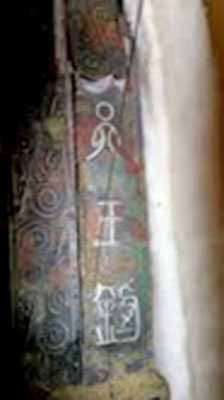


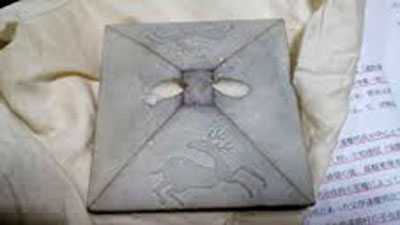











 Sat Mar 23, 2024 11:33 pm by globalturbo
Sat Mar 23, 2024 11:33 pm by globalturbo








